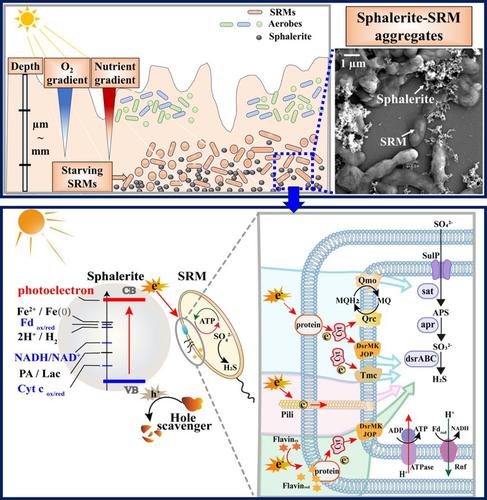当前位置:
X-MOL 学术
›
Environ. Microbiol.
›
论文详情
Our official English website, www.x-mol.net, welcomes your
feedback! (Note: you will need to create a separate account there.)
Photoelectron‐promoted metabolism of sulphate‐reducing microorganisms in substrate‐depleted environments
Environmental Microbiology ( IF 4.3 ) Pub Date : 2024-10-01 , DOI: 10.1111/1462-2920.16683 Chao Zhong, Anhuai Lu, Hailiang Dong, Shan Huang, Liang Shi, Yanan Shen, Yangjian Cheng, Yiran Dong, Xiangzhen Li, Jie Xu, Jinren Ni, Michael F. Hochella, Juan Liu
Environmental Microbiology ( IF 4.3 ) Pub Date : 2024-10-01 , DOI: 10.1111/1462-2920.16683 Chao Zhong, Anhuai Lu, Hailiang Dong, Shan Huang, Liang Shi, Yanan Shen, Yangjian Cheng, Yiran Dong, Xiangzhen Li, Jie Xu, Jinren Ni, Michael F. Hochella, Juan Liu

|
Sulphate‐reducing microorganisms, or SRMs, are crucial to organic decomposition, the sulphur cycle, and the formation of pyrite. Despite their low energy‐yielding metabolism and intense competition with other microorganisms, their ability to thrive in natural habitats often lacking sufficient substrates remains an enigma. This study delves into how Desulfovibrio desulfuricans G20, a representative SRM, utilizes photoelectrons from extracellular sphalerite (ZnS), a semiconducting mineral that often coexists with SRMs, for its metabolism and energy production. Batch experiments with sphalerite reveal that the initial rate and extent of sulphate reduction by G20 increased by 3.6 and 3.2 times respectively under light conditions compared to darkness, when lactate was not added. Analyses of microbial photoelectrochemical, transcriptomic, and metabolomic data suggest that in the absence of lactate, G20 extracts photoelectrons from extracellular sphalerite through cytochromes, nanowires, and electron shuttles. Genes encoding movement and biofilm formation are upregulated, suggesting that G20 might sense redox potential gradients and migrate towards sphalerite to acquire photoelectrons. This process enhances the intracellular electron transfer activity, sulphur metabolism, and ATP production of G20, which becomes dominant under conditions of carbon starvation and extends cell viability in such environments. This mechanism could be a vital strategy for SRMs to survive in energy‐limited environments and contribute to sulphur cycling.
中文翻译:

底物耗尽环境中硫酸盐还原微生物的光电子促进代谢
硫酸盐还原微生物(SRM)对于有机分解、硫循环和黄铁矿的形成至关重要。尽管它们的能量代谢较低且与其他微生物竞争激烈,但它们在经常缺乏足够底物的自然栖息地中繁衍生息的能力仍然是一个谜。这项研究深入探讨了 Desulfovibrio desulfuricans G20(一种代表性的 SRM)如何利用细胞外闪锌矿(ZnS)(一种经常与 SRM 共存的半导体矿物)的光电子来进行新陈代谢和能量生产。闪锌矿批量实验表明,与黑暗条件下(不添加乳酸)相比,光照条件下 G20 还原硫酸盐的初始速率和程度分别增加了 3.6 倍和 3.2 倍。对微生物光电化学、转录组学和代谢组学数据的分析表明,在没有乳酸的情况下,G20 通过细胞色素、纳米线和电子穿梭机从细胞外闪锌矿中提取光电子。编码运动和生物膜形成的基因上调,表明 G20 可能感知氧化还原电位梯度并迁移到闪锌矿以获得光电子。这一过程增强了细胞内电子转移活性、硫代谢和 G20 的 ATP 产生,G20 在碳饥饿条件下占主导地位,并延长了细胞在此类环境中的生存能力。这种机制可能是 SRM 在能源有限的环境中生存并有助于硫循环的重要策略。
更新日期:2024-10-01
中文翻译:

底物耗尽环境中硫酸盐还原微生物的光电子促进代谢
硫酸盐还原微生物(SRM)对于有机分解、硫循环和黄铁矿的形成至关重要。尽管它们的能量代谢较低且与其他微生物竞争激烈,但它们在经常缺乏足够底物的自然栖息地中繁衍生息的能力仍然是一个谜。这项研究深入探讨了 Desulfovibrio desulfuricans G20(一种代表性的 SRM)如何利用细胞外闪锌矿(ZnS)(一种经常与 SRM 共存的半导体矿物)的光电子来进行新陈代谢和能量生产。闪锌矿批量实验表明,与黑暗条件下(不添加乳酸)相比,光照条件下 G20 还原硫酸盐的初始速率和程度分别增加了 3.6 倍和 3.2 倍。对微生物光电化学、转录组学和代谢组学数据的分析表明,在没有乳酸的情况下,G20 通过细胞色素、纳米线和电子穿梭机从细胞外闪锌矿中提取光电子。编码运动和生物膜形成的基因上调,表明 G20 可能感知氧化还原电位梯度并迁移到闪锌矿以获得光电子。这一过程增强了细胞内电子转移活性、硫代谢和 G20 的 ATP 产生,G20 在碳饥饿条件下占主导地位,并延长了细胞在此类环境中的生存能力。这种机制可能是 SRM 在能源有限的环境中生存并有助于硫循环的重要策略。































 京公网安备 11010802027423号
京公网安备 11010802027423号